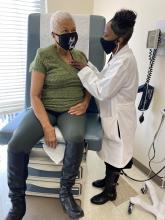––
The reasons for this less frequent contact and the ramifications for patients and doctors practicing primary care are unclear, according to various experts. But some offered possible explanations for the changes, with patients’ increased participation in high deductible plans and shortages in primary care physicians (PCPs) being among the most often cited.
The findings, which were published online Jan. 11 in Annals of Family Medicine, were derived from researchers using a repeated cross-sectional study of the 2002-2017 Medical Expenditure Panel Survey to characterize trends in primary care use. This survey, which collected information about medical care utilization from individuals and families, included 243,919 participants who were interviewed five times over 2 years. The authors defined primary care physician contact as “in-person visit or contact with a primary care physician (primarily telephone calls) with a reported specialty of family medicine, general internal medicine, geriatrics, general pediatrics, or general practice physician.” According to the paper, “the proportion of individuals with any primary care physician contact was determined for both the population and by age group using logistic regression models,” and negative binomial regression models were used to determine the number of contacts among people with visits during 2-year periods.
The study authors, Michael E. Johansen, MD, MS, and Joshua D. Niforatos, MD, MTS, said their study suggests that previously reported decreases in primary care contact was caused by fewer contacts per patient “as opposed to an absolute decrease in the number of patients in contact with primary care.”
Harold B. Betton, MD, PhD, who practices family medicine in Little Rock, Ark., questioned this claim.
“In my reading, the authors concluded that people are seeing their primary care physicians fewer times than in the past, which suggests something is happening,” Dr. Betton said in an interview. “The fact that fewer visits are occurring may be due to multiple things, i.e., urgent care visits, visits to physician extenders – physician assistants and advanced practice nurses – or emergency room visits.”
"The paper draws observational conclusions and I fail to see the merit in the observation without knowing what the respondents were asked and not asked," he added.
Other primary care physicians suggested patients’ participation in alternative pay models and high-deductible plans have played a factor in the declines.
“Most of us have gone from fee-for-service, volume-based care to more value-based care,” Ada D. Stewart, MD, president of the American Academy of Family Physicians, said in an interview. The data reflect that trend, “whereas we were rewarded more for the number of people we were seeing, now we are trying to get towards more of the value that we provide,” suggested Dr. Stewart, who also practices family medicine with Cooperative Health in Columbia, S.C.
“Given the rise of high-deductible plans and copays, it is not surprising that younger patients, a generally healthier population, might well decrease their visits to a primary care physician. I would suspect that data for patients over 50 might well be different,” William E. Golden, MD, who is medical director at the Arkansas Department of Health & Human Services, noted in an interview.
Eileen Barrett, MD, MPH, also cited greater participation in high-deductible plans as a possible factor that could be leading some patients to forgo visits, as well as increased financial insecurity, rendering it expensive to have the visit and also to take time from work for the visit.
“I would wonder if some of this is also due to how overloaded most primary care offices are so that instead of stopping accepting new patients or shedding patients, it is just harder for existing patients to be seen,” said Dr. Barrett, who is a general internist and associate professor in the division of hospital medicine, department of internal medicine, at the University of New Mexico, Albuquerque. “Some of this could be from administrative burden – 2 hours per hour of clinic – and consequently reducing clinical time,” continued Dr. Barrett, who also serves on the editorial advisory board of Internal Medicine News, which is affiliated with Family Practice News.
Other experts pointed to data showing an insufficient supply of PCPs as a potential explanation for the new study’s findings. The Health Resources and Services Organization, for example, reported that 83 million Americans live in primary care “health professional shortage areas,” as of Jan. 24, 2021, on their website.




